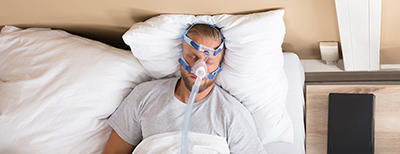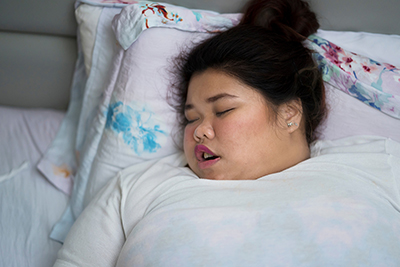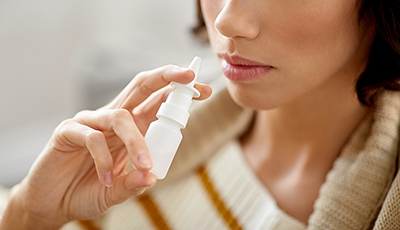Snoring: Treat It at the Source
Picture the dawn of time. Caveman Ugg is curled up by the fire, his family sleeping soundly around him. Suddenly, a sound like a snorting aurochs fills the room. The baby screams. Emm wakes up and pushes Ugg over onto his side. Blissfully, the noise stops and the family returns to their slumber. Did Emm ever wonder why Ugg made that horrible noise, and how she might stop it from happening again?
Awake or asleep, our breathing is normally quiet. Snoring is the sound we make when we breathe through a partially obstructed airway. There may be several reasons for this obstruction, ranging from anatomical variations to inflammation. Find the cause of the snoring, and you have the key to solving the problem.
 It’s not unusual for us to snore for a short time if we have a cold or if our seasonal allergies are acting up. Snoring is much more of a concern if you snore regularly, especially if your partner has noticed brief periods when you stop breathing through the night. Your first step in tackling your snoring needs is to make an appointment with your health-care practitioner.
It’s not unusual for us to snore for a short time if we have a cold or if our seasonal allergies are acting up. Snoring is much more of a concern if you snore regularly, especially if your partner has noticed brief periods when you stop breathing through the night. Your first step in tackling your snoring needs is to make an appointment with your health-care practitioner.
One reason for snoring is a serious condition called obstructive sleep apnea (OSA). OSA leads to oxygen deprivation, which can result in various chronic diseases. More than 1 in 5 Canadians have either been diagnosed with OSA or are at very high risk of it.[i] The only way to diagnose OSA is through a sleep study. This is a painless procedure, ordered by your doctor. It is usually performed in a sleep laboratory in a hospital, where you are monitored through the night. In some cases, a home sleep study might be done instead. Treatment of OSA is using a continuous positive airway pressure (CPAP) device, which helps you breathe more effectively by preventing the soft tissue at the back of your throat from collapsing.
A doctor can also examine your nose and throat to see if there are any anatomical problems such as a deviated septum, nasal polyps, or enlarged tonsils which might be contributing to snoring. Review your medications with the doctor as well. Medications that relax muscles, such as benzodiazepines, can also relax the back of the throat, resulting in snoring.[ii] Alcohol, especially taken close to bedtime, has the same effect.[iii], [iv] Smoking tobacco or cannabis can contribute to snoring by inflaming and irritating the airway. In fact, bad air of any kind (think wildfire smoke, mold, smog, and pet dander), can increase the chance that you will snore.[v]
 If you do not have sleep apnea, your airway anatomy is normal, and the air you breathe is pristine, then there may be another medical reason for snoring. Chronic sinusitis, allergies, or gastrointestinal reflux disease (GERD) can all cause swelling in the airway, impeding the airflow.[vi] A large neck circumference, often resulting from overweight or obesity, can put pressure on the tissues of the airway, interfering with the flow of air.[vii]
If you do not have sleep apnea, your airway anatomy is normal, and the air you breathe is pristine, then there may be another medical reason for snoring. Chronic sinusitis, allergies, or gastrointestinal reflux disease (GERD) can all cause swelling in the airway, impeding the airflow.[vi] A large neck circumference, often resulting from overweight or obesity, can put pressure on the tissues of the airway, interfering with the flow of air.[vii]
While you are waiting for specialist appointments, here are a few things you can try yourself to get some relief from snoring:
- If your thick neck is due to increased weight, then losing weight may be helpful in reducing snoring and decreasing your OSA risk.
- To help with acid reflux, avoid eating a few hours before bed. Consider trying probiotics or digestive enzymes to help with digestion. Raise the head of your bed by using blocks of wood under the legs. Sleeping on a wedge pillow may also be helpful.
 If your nose is congested at night, try using a saline rinse before bed. This helps wash away pollen, dust, and bacteria from the nasal passages, and the salt in the solution causes the tissue to shrink, reducing inflammation.[viii]
If your nose is congested at night, try using a saline rinse before bed. This helps wash away pollen, dust, and bacteria from the nasal passages, and the salt in the solution causes the tissue to shrink, reducing inflammation.[viii]- Snoring is worse in damp homes with high pollution. Get a good air purifier, take care of mold issues, and keep pets out of the bedroom.
- Lying on your side should help you breathe better. There are special vests you can buy that prevent you from rolling onto your back, or you can simply sew a piece of pool noodle to the back of your pyjama.[ix]
We can’t solve the problem of Ugg’s snoring for Emm. It might have been anything from the smoke of the fire irritating his throat to the reflux from that last large aurochs’ leg he polished off before falling asleep. You, however, now have a few more ideas to figure out your own snoring, and some possible solutions. Good luck and here’s to sleeping like a (nonsnoring) baby!
 Wendy Presant, RHNC, CFMP
Wendy Presant, RHNC, CFMP
With a background in nursing, naturopathic, and functional medicine, Wendy Presant is currently registered as a health-and-nutrition counsellor. She provides virtual coaching services to individuals looking to optimize their health.
naturalcoachathome.care
[i] Evans, J., R. Skomro, H. Driver, B. Graham, I. Mayers, L. McRae, J. Reisman, C. Rusu, T. To, and J. Fleetham. “Sleep laboratory test referrals in Canada: Sleep Apnea Rapid Response Survey.” Canadian Respiratory Journal, Vol. 21, No. 1 (2014): e4–e10.
[ii] Lin, B.M., F.B. Hu, and G.C. Curhan. “Benzodiazepine use and snoring in women: the Nurses’ Health Study.” JAMA Otolaryngology – Head & Neck Surgery, Vol. 143, No. 2 (2017): 162–167.
[iii] Burgos-Sanchez, C., N.N. Jones, M. Avillion, S.J. Gibson, J.A. Patel, J. Neighbors, S. Zaghi, and M. Camacho. “Impact of alcohol consumption on snoring and sleep apnea: a systematic review and meta-analysis.” Otolaryngology–Head and Neck Surgery, Vol. 163, No. 6 (2020): 1078–1086.
[iv] Sleep Centers of Middle Tennessee. Relationship between smoking, snoring, and sleep apnea. https://sleepcenterinfo.com/blog/relationship-smoking-snoring-sleep-apnea/ · 2023-01-12.
[v] Silverforsen, D., J. Theorell-Haglöw, M. Ljunggren, R. Middelveld, J. Wang, K. Franklin, D. Norbäck, et al. “Snoring and environmental exposure: Results from the Swedish GA2LEN study.” BMJ Open, Vol. 11, No. 6 (2021): e044911.
[vi] Charaklias, N., C. Mamais, V. Pothula, and B.N. Kumar. “Laryngopharyngeal reflux and primary snoring: A pilot case-control study.” B-ENT, Vol. 9, No. 2 (2013): 89–93.
[vii] Chiang, J.-K., Y.-C. Lin, C.-M. Lu, and Y.-H. Kao. “Snoring index and neck circumference as predictors of adult obstructive sleep apnea.” Healthcare, Vol. 10, No. 12 (2022): 2543.
[viii] Jiang, M., J. Chen, Y. Ding, C. Gan, Y. Hou, J. Lei, M. Wan, X. Li, and Z. Xiao. “Efficacy and safety of sea salt-derived physiological saline nasal spray as add-on therapy in patients with acute upper respiratory infection: A multicenter retrospective cohort study.” Medical Science Monitor, Vol. 27 (2021): e929714-1–e929714-7.
[ix] Ravesloot, M.J.L., J.P. van Maanen, L. Dun, and N. de Vries. “The undervalued potential of positional therapy in position-dependent snoring and obstructive sleep apnea—a review of the literature.” Sleep and Breathing, Vol. 17, No. 1 (2013): 39–49.

 Stores
Stores